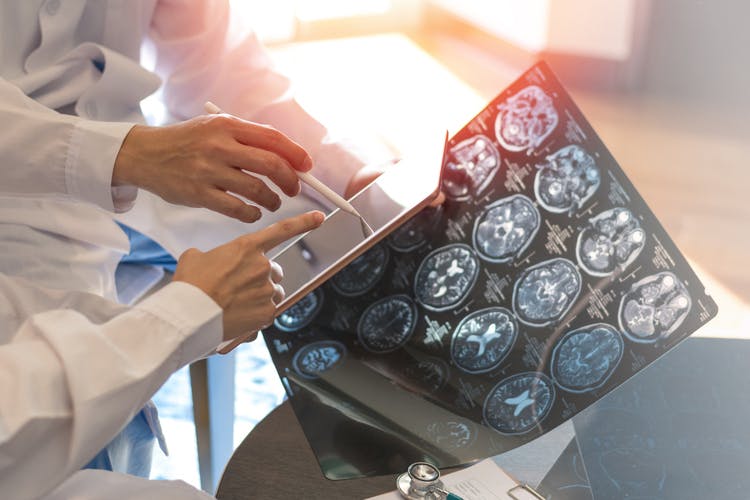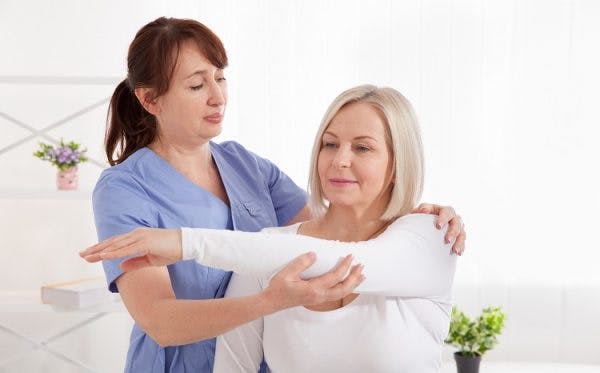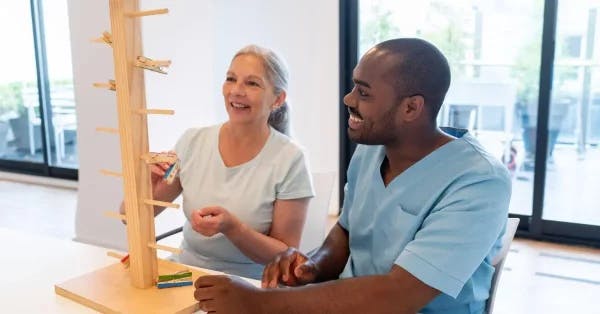Mixed transcortical aphasia is a severe form of aphasia that causes an inability to speak or understand others. It is similar to global aphasia in that it affects multiple aspects of a person’s language skills. However, individuals with mixed transcortical aphasia can still repeat words they hear, even an entire sentence.
This article will review the causes and characteristics of mixed transcortical aphasia, as well as management options.
Use the links below to jump straight to any section:
What is Mixed Transcortical Aphasia?
Mixed transcortical aphasia is a rare and unique language disorder, presenting in only 1-3% of all aphasia cases. Aphasia usually results from damage to Broca’s area and Wernicke’s areas, the primary language centers of the brain.
However, in mixed transcortical aphasia, Broca’s and Wernicke’s areas are left intact, while the surrounding language association areas are damaged. These areas surround Broca’s and Wernicke’s areas, connecting these vital language production and comprehension areas with the rest of the brain.
Doctors believe that damage to the language association areas actually isolates Broca’s and Wernicke’s areas from the rest of the brain. This prevents the production of spontaneous speech and comprehension of written and spoken language. Because of the isolation of Broca’s and Wernicke’s areas, this type of aphasia is also referred to as isolation aphasia.
Causes of Mixed Transcortical Aphasia
The most common cause of mixed transcortical aphasia is a left hemisphere watershed stroke, also called a border-zone stroke. This type of stroke occurs when blood flow is compromised to the areas of the brain furthest from the major cerebral arteries.
These areas, referred to as watershed regions, are supplied with blood from the farthest reaching branches of two major cerebral arteries. This places them on the border between the areas perfused by each artery. Because watershed regions are so far from the main arterial supply, they are especially vulnerable to a decrease in blood flow.
In mixed transcortical aphasia, the left hemisphere watershed regions between the anterior and middle cerebral arteries as well as the middle and posterior cerebral arteries are affected. This is most commonly seen among those with severe narrowing (stenosis) of the left internal carotid artery.
Symptoms
Mixed transcortical aphasia shares many of the same characteristics as global aphasia, such as the inability to effectively speak or comprehend language. However, it can be distinguished from other aphasias by the striking ability to repeat words, phrases, and even entire sentences, despite not comprehending what is being said. This makes it the functional opposite of conduction aphasia, in which the person cannot repeat any words at all.
The most common symptoms of mixed transcortical aphasia include:
- Slow, halting speech
- Speech does not have typical rhythm or prosody
- Spoken language is mostly a repetition of what was said to them (echolalia)
- May be unaware of echolalia and/or repeat words involuntarily
- Difficulty initiating speech
- Impaired reading and writing abilities
- Repetition skills are completely intact or only mildly impaired
It is also important to note that mixed transcortical aphasia is a cognitive disorder rather than a motor disorder. Individuals with mixed transcortical aphasia retain the oral-motor skills to physically express themselves. However, the cognitive ability to produce and comprehend language, outside of repeating words, is impaired.
Because mixed transcortical aphasia is so similar to global aphasia, treatment will also take a similar approach. Focusing on early intensive therapy can help individuals achieve an optimal recovery.
Treatment Options
Speech therapy is generally considered the most effective treatment for mixed transcortical aphasia, as well as other types of aphasia. This is because speech therapists use exercises and activities focused on activating neuroplasticity.
Neuroplasticity refers to the brain’s ability to form neural pathways in response to repetition or changes in the environment. These pathways can allow undamaged portions of the brain to take control of functions that were previously controlled by damaged ones. Therefore, even if a stroke severely damages the brain regions that normally control language association, it is still possible for other areas to compensate.
To activate neuroplasticity and maximize recovery, individuals must engage in repetitious exercise. As the brain is stimulated through repetitive exercise, it creates and strengthens neural pathways in response. Practicing more repetitious exercise results in more neuroplastic changes. As neural pathways are created and strengthened, individuals will begin to regain language skills.
Since mixed transcortical aphasia is fairly rare, there is not a lot of research regarding treatments designed specifically to address it. However, here are a few techniques that speech therapists may use:
Drawing Therapy
As individuals with mixed aphasias have difficulties with both language expression and comprehension, therapies involving considerable language expression demands or significant verbal or written directions may be very challenging. Therefore, many speech therapists initially recommend techniques involving limited language, such as drawing therapy.
Mixed transcortical aphasia affects the associated language areas in the left hemisphere of the brain. Drawing has been shown to activate regions in the right hemisphere, which can allow survivors to access knowledge in the unaffected areas of their brain to communicate.
Although drawing is frequently used as a compensation method to help individuals with aphasia communicate, studies have found that using drawing as a form of therapy can improve naming abilities. This may be because it activates the right hemisphere of the brain during the word retrieval process
It’s important to note that the act of drawing itself is critical for engaging the brain, rather than the quality of the drawing. Therefore, even people without any artistic background can benefit from drawing therapy.
Melodic Intonation Therapy
Melodic intonation therapy (MIT), also referred to as singing therapy, can be a very effective treatment for individuals with non-fluent aphasias. Similar to drawing, music and singing activate the more creative right hemisphere of the brain, contributing to brain rewiring and recovery.
During MIT, individuals use different pitches and rhythms to produce language through singing. As individuals improve, they may be able to lessen the musical characteristics of their verbal expression until they are speaking rather than singing. This therapy can be carried out by music therapists or speech therapists, either distinctly or using a combined approach.
Compensatory Methods
Although stimulating the brain through therapeutic exercises and activities is the best way to regain language skills, learning compensatory methods can allow individuals to communicate despite their deficits. For example, some individuals with aphasia may use gestures, drawings, or pictures to communicate.
There are a variety of types of alternative and augmentative communication (AAC) methods and devices, which can be used as tools to assist in communication while individuals are recovering. Speech therapists are the experts in this field, and can recommend and train survivors and their families to use language-free communication methods effectively.
Recovery Outcomes
Studies have shown that although many individuals are able to recover at least some of their language skills, 61% of stroke survivors still have speech problems one year after their stroke. Because mixed transcortical aphasia is a severe form of aphasia, the recovery may take even longer.
However, while aphasia recovery can take years, improvement is always possible. In fact, even decades after a stroke, neuroplastic changes in the brain can still occur. Studies have even demonstrated that half of all chronic stroke survivors continue to recover from aphasia, even years after their stroke.
The brain requires constant stimulation to trigger neuroplasticity. That’s why practicing speech therapy exercises daily is crucial. Practicing for even ten minutes per day can lead to significant long-term benefits. The more the brain is stimulated, the more progress individuals can make toward recovery.
Understanding Mixed Transcortical Aphasia
Mixed transcortical aphasia is a severe type of aphasia that impairs an individual’s speech and comprehension skills. However, the ability to repeat what they’ve heard remains intact. Therefore, those with mixed transcortical aphasia will frequently repeat what they hear others say, a condition known as echolalia.
Because mixed transcortical aphasia shares so many similarities with global aphasia, treatment can also take a similar approach. Drawing therapy, singing therapy, and compensatory methods may be used by speech therapists to improve language and communication skills.
As with all types of aphasia, the best way to recover is to work closely with a speech therapist, who can assess one’s symptoms and devise a treatment plan that meets their specific needs. Recovery from mixed transcortical aphasia may take time, but with regular practice, there is always hope for recovery.










